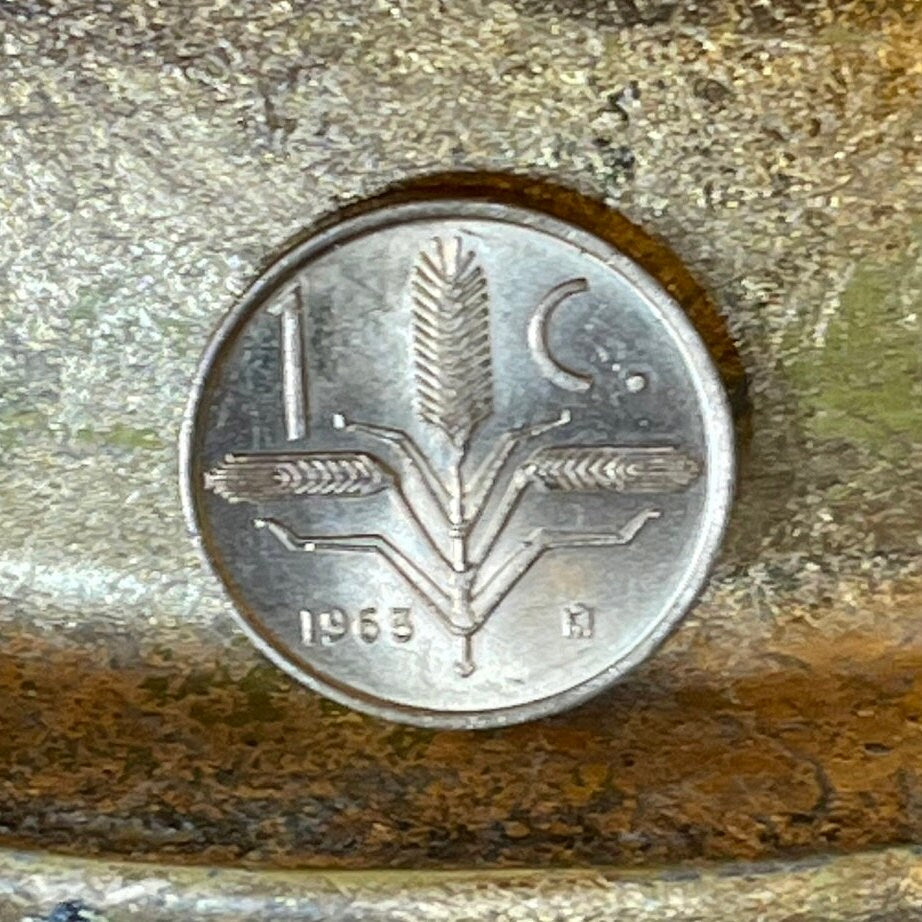elemintalshop
Wheat Ears & Eagle w/Snake 1 Centavo Mexico Authentic Coin Money for Jewelry and Craft Making
Wheat Ears & Eagle w/Snake 1 Centavo Mexico Authentic Coin Money for Jewelry and Craft Making
Couldn't load pickup availability
Wheat Ears & Eagle w/Snake 1 Centavo Mexico Authentic Coin Charm for Jewelry and Craft Making
Obverse: The national arms of Mexico
Lettering: ESTADOS UNIDOS MEXICANOS
Translation: United Mexican States
Reverse: Wheat-ear at the center with leaves going to the sides and the denomination in numerals at the top-left, and the abbreviation for the denomination to the top-right with the date to the bottom-left and the mintmark to the bottom-right
Lettering: 1 C.
Translation: 1 Centavo
Features
Issuer Mexico
Period United Mexican States (1905-date)
Type Standard circulation coin
Years 1950-1969
Value 1 Centavo (0.01 MXP)
Currency Peso (1863-1992)
Composition Brass
Weight 2 g
Diameter 16 mm
Thickness 1.25 mm
Shape Round
Technique Milled
Orientation Coin alignment ↑↓
Demonetized Yes
Number N# 996
References KM# 417, Schön# 41
Wikipedia:
The growing of crops is the most important aspect of Mexico’s agriculture, accounting for fifty percent of agricultural output. Main crops include corn, sugarcane, sorghum, wheat, tomatoes, bananas, chili peppers, oranges, lemons, limes, mangos, other tropical fruits, beans, barley, avocados, blue agave and coffee. The most important crops for national consumption are wheat, beans, corn and sorghum. The most important export crops are sugar, coffee, fruits and vegetables, most of which are exported to the United States. The most important animal feed crop is alfalfa followed by sorghum and corn.
Corn is still the most important crop in Mexico, grown on almost sixty percent of its cropland and contributing to just over nine percent of human calorie intake and fourteen percent of protein intake. Central Mexico grows about sixty percent of the country’s corn, almost exclusively in the rainy season from June to October. While self-sufficient in the production for human consumption, half of Mexico’s grain imports are for feed corn for animals.
Many of these crops are important regionally. Wheat is the most important crop in the northwest, now the center of Mexico’s grain production. Other important crops in the northwest are winter vegetables such as tomatoes and lettuce as well as oilseeds. The traditional area for grain production in Mexico was the Bajío region. The region still produces wheat, corn, vegetables, peanuts, strawberries and beans, mostly on small holdings. Wine grapes are grown in areas such as Baja California, Coahuila and Querétaro. Mexico produces two crops not generally produced elsewhere, henequen used to produce a strong fiber and maguey, both in the agave family. Maguey is used for the making of pulque as well as mezcal. Tequila is a type of mezcal made from the blue agave in a designated zone mostly in Jalisco.
The production of some important export crops, such as avocados from the state of Michoacan, have been the target of drug cartels that extort producers.
In 2018 the country produced 56.8 million tons of sugar cane (6th largest producer in the world), 27.1 million tons of maize (8th largest producer in the world), 4.7 million tons of orange (4th largest producer in the world), 4.5 million tons of tomato (9th largest producer in the world), 4.5 million tons of sorghum (6th largest producer in the world), 3.3 million tons of chili pepper (2nd largest producer in the world), 2.5 million tons of lemon (2nd largest producer in the world), 2.2 million tons of mango (5th largest producer in the world), 2.1 million tons of avocado (largest producer in the world), 1.15 million tons of coconut (6th largest producer in the world) and 1 million tons of papaya (3rd largest producer in the world). In addition to these, Mexico also produced in 2018: 2.9 million tons of wheat, 2.3 million tons of banana, 1.8 million tons of potato, 1.5 million tons of onion, 1.4 million tons of watermelon, 1.2 million tons of beans, 1 million tons of pineapple, 1 million tons of barley, 1 million tons of cucumber / pickles, 983 thousand tons of palm oil, in addition to smaller yields of other agricultural products.
***************
Wikipedia:
The coat of arms of Mexico (Spanish: Escudo Nacional de México, literally "national shield of Mexico") depicts a Mexican (golden) eagle perched on a prickly pear cactus devouring a rattlesnake. The design is rooted in the legend that the Aztec people would know where to build their city once they saw an eagle eating a snake on top of a lake. The image has been an important symbol of Mexican politics and culture for centuries. To the people of Tenochtitlan, this symbol had strong religious connotations, and to the Europeans, it came to symbolize the triumph of good over evil (with the snake sometimes representative of the serpent in the Garden of Eden).
The Law on the National Arms, Flag, and Anthem regulates the design and use of the arms. They feature in the centre of the flag of Mexico, are engraved on the obverse of Mexican peso coins, and are the basis of the Seal of the United Mexican States, the seal used on any official documents issued by the federal, state or municipal governmental authorities. The seal differs from the arms by the addition of the words Estados Unidos Mexicanos ("United Mexican States", the full official name of the country) in a semicircle around the upper half.
Share










5 stars review from Vicki









